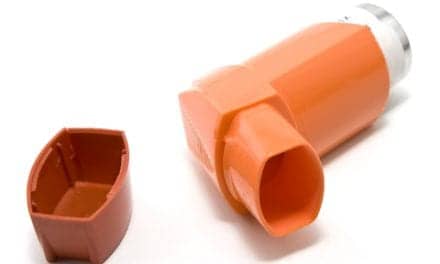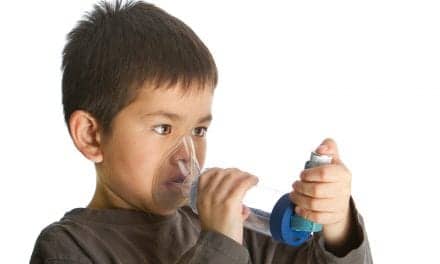Mothers of Asthmatics is providing asthma education, research, coping strategies, and emotional support to those families with asthmatic children.
“We’re no longer the Lone Ranger,” says Nancy Sander, founder and president of the Asthma and Allergy Network, Mothers of Asthmatics. Known affectionately to its members as “MA,” the organization was conceived in 1985 as a hotline for bewildered and frightened parents. According to Sander, the group was virtually the only source of peer support and/or information for parents at the time it was formed. Today, 14 years later, dozens of organizations are involved in asthma education, research, and advocacy. But although Sander and the other Mothers of Asthmatics are no longer alone, no other group speaks for people with asthma or their families with the same fierce conviction.
“I started the organization because I had become totally exhausted trying to find help for my daughter, Brooke,” Sander says. For the first few years after Brooke was born with severe asthma, food allergies, and gastroesophageal reflux, Sander spent much of her time taking the child back and forth to emergency departments. “No one seemed to have any answers for me and no one gave me any hope,” Sander says. It was only after Brooke was enrolled in a study at Georgetown University Hospital that Sander was introduced to the peak flow meter and daily symptom diary. “Then I was told that Brooke’s asthma really could be controlled–that some day she would be just like her friends who did not wheeze,” Sander recalls. “It was the first time I had heard that.”
Eager to share this information with other parents, Sander launched a newsletter, the MA Report, to be distributed in the metropolitan Washington, DC, area. Not long afterward, she founded a network to give parents a way to discuss what they were learning about the practical side of managing asthma and allergies. As important as it was to have information about the most up-to-date treatments, Sander realized that there was more to controlling asthma than that. Caring providers, good communication, coping strategies, and emotional support were also important. So were family dynamics. “We concentrated on the family aspect of living with this disease, rather than the technical aspect. That is, we didn’t just talk about the technology, we talked about how to make the technology work in our homes,” Sander says.
Since the primary care community had been slow to take an interest in peak flow meters, Sander’s group began to sell the devices through its newsletter. In response, according to Sander, the organization heard objections from many physicians who dismissed the devices as mere gimmicks. “So we had to educate the physician community as well as health care consumers,” Sander says. Today there is no need to convince anyone that peak flow monitoring is worthwhile. “But we still have to work to make sure that people do it correctly,” Sander says.
Initially, the Mothers of Asthmatics had to struggle to be heard, but recently it has become evident that physicians and other health care providers have been getting the message. When the National Asthma Education and Prevention Program was developing its 1991 and 1997 guidelines for the management of asthma, Sander was asked to serve on the coordinating committee that would review draft chapters prepared by the expert panels. As Sander points out, a revolutionary feature of the 1997 guidelines is a requirement for including the family in asthma education, care planning, and assessment–even to the extent of surveying the family, as well as the patient, about their satisfaction with care. “It was an ongoing process to get the committee thinking in those terms,” says Sander, who regularly reminded committee members not to forget the family dimension. “Although we weren’t the only group advocating that approach, we were certainly one of the earliest to recommend it,” Sander notes. Once the guidelines were developed, she helped to promote them, serving on the school committee and the patient, public, and physician awareness committees.
While providers look increasingly to the Mothers of Asthmatics to help them understand the patient perspective, families look to the organization for help in understanding some of the new, confusing issues that have resulted from advances in the field of asthma. According to Sander, increased public awareness of asthma has made a huge difference in the availability of good treatment. At the same time, the issues families must deal with have become more contentious and complex.
In 1999, Sander will distribute a special edition of the MA Report covering a potentially explosive issue: the decision of the FDA to label all inhaled corticosteroids with precautionary wording about potential adverse effects on children’s growth. While Sander emphasizes that there are not yet clear answers to the questions this decision raises about therapy, she intends to arm parents with the full background information they will need to interpret the labeling calmly, in the context of their own children’s needs. To ensure that everyone who needs this information receives it, she hopes to distribute 1 million copies of the newsletter.
The scale of this project, however, belies the personal nature of the group. Sander and the other Mothers of Asthmatics have never abandoned their commitment to be available to families. Callers to the group’s toll-free number in Fairfax, Va, are greeted by a friendly voice that presents several options, then offers: “To speak to Nancy Sander, just stay on the line.” She is always free to talk to a parent.
“We get calls and we get emails every day from all over the country,” Sander says. Although requests for help can be categorized in several different ways, the most frequent call for help comes soon after the diagnosis. “They say, ‘My doctor, or my respiratory therapist, or my nurse told me about your organization. I’ve just been diagnosed and I don’t know where to begin. I’m overwhelmed and I’m scared,’ ” Sander recounts.
“When you are overwhelmed, it seems as though the world is caving in on you. You pick up the phone because your doctor or someone you trusted said that you should call this number,” Sander says. “And when people call us, first of all what they hear on the other end is someone trying to direct their call in a manner that will help them,” Sander says.
Often, the caller does not even know what questions to ask. “We realize that they have not had time to sort things out,” Sander says. She offers to send introductory materials so callers can get their bearings. “Then they can call us at any time.”
The Mothers of Asthmatics currently publishes several books including A Parent’s Guide to Asthma, The Best Guide to Allergy, and The Peak Flow Meter Book. It has also produced several videos. The most recent, Baby Breaths, gives parents information about administering treatments to this hard-to-keep-still population, while at the same time giving wiggly toddlers something to watch while they are nebulizing. Materials can be ordered by phone or through the newsletter.
Currently there are 6,000 members, including 1,000 health care professionals. Members receive the newsletter as well as access to many publications and helpful discounts. The organization now employs a staff of 12, including a marketing director, finance officer, fulfillment specialist, project manager, and director of outreach. A member services coordinator handles the member database and a managing editor, graphic designer, and proofreader produce the organization’s publications. Funds come from the United Way and other charitable sources, as well as from pharmaceutical and equipment companies. The American Academy of Allergy, Asthma and Immunology and the American Association for Respiratory Care also provide support. In addition to two part-time medical editors, Paul Ehrlich, MD, and Martha White, MD, a medical advisory board reviews specific articles that are being prepared for publication and helps to research specific questions.
Sander emphasizes that MA is not a conventional support group. Rather, it is an educational organization. “We have volumes of information here and we will do information searches free of charge if an individual has a question we can’t answer,” Sander says. If the organization’s resources do not contain the answer, she will contact researchers or pharmaceutical companies for the information. Sander herself is dedicated to clarifying medical issues and has mastered the art of bringing esoteric information to the very concrete level at which patients and parents must use it.
Currently, her group is working to smooth the transition to non-CFC inhalers. As chlorofluorocarbon propellants are withdrawn from the market to protect Earth’s ozone layer, metered dose inhalers (MDIs) for albuterol and other asthma medications are being reformulated. While new patients will not be affected, long-time users of the old MDIs may notice a different taste, or a different speed to the puff of medication. Sander sees the transition as an opportunity to review MDI technique and remind patients of the importance of keeping count of the number of puffs they have used. Otherwise, the canister may become depleted of drug, leaving propellant behind. “Just because there is something in there does not mean it is effective,” Sander says.
For the time being, she continues to recommend that users shake the canister before actuating it. The new, so-called HFA
inhalers are said to have complete medication from first dose to last. However, Sander is not willing to pass along this reassurance until it has been proven in widespread use. “What I am sure of is that if users shake the canister first, they will have the correct ratio of drug to propellant right to the end,” Sander says.
She is equally conservative when it comes to the issue of growth retardation and inhaled steroids. “Not only has it been difficult for us to reach physicians who know enough about the problem, when we have succeeded in talking to those doctors, it has been difficult for them to admit that they don’t have the answers yet,” Sander says. Some physicians have said that only large doses of inhaled steroids are at issue, which Sander believes may or may not be true. Other experts recommend use of a sophisticated growth measuring device, the stadiometer, while others hold that it is unnecessary.
“My own impression, after being present at the FDA meeting, was that the data are still very sparse,” Sander says. In particular, the panel could not determine what dose of inhaled steroids or what duration of use would be needed to affect a child’s growth. “All they know is that there may be some potential. They don’t know how to detect a deviation in growth reliably. And what do you do if you find a deviation?” Sander wonders.
She predicts that the new labeling will create a lot of worry among parents. “We already know there is going to be a problem because when the FDA first made its announcement, although it didn’t get a great deal of press coverage, we still received a lot of calls,” Sander says. Her intent in the special newsletter is not to take a position on the FDA’s decision as being good or bad, but rather to present the facts surrounding the issue. The newsletter will list all medications affected by the class labeling, include information about the mechanisms of asthma and allergic rhinitis, and review the effects of the inhaled steroids.
“We don’t give medical advice and we never say what we ourselves would do. What we do tell people is that their concerns are the same as those of many other families. We can present a basic overview of what is known about inhaled cortico-steroids, and we can send information in the mail that will help people stay on target,” Sander says. This means that she hopes to forestall fears that might cause a parent to pull their child off inhaled steroids suddenly. “We’re hoping to prevent that by anticipating the parent’s fear,” Sander says.
In 1999 the Mothers of Asthmatics will focus on the school-age child with asthma. Sander would like to establish the right of children to carry their inhaler on their person in school. “Just as some children need prescription eyeglasses, other children need prescription airways,” Sander says. She will also advocate for more school nurses. According to Sander, only half the public schools in the United States currently employ a school nurse.
School nurses as well as other health care providers frequently request materials from the Mothers of Asthmatics. According to Sander, the group’s materials go beyond presenting expert information to focus on the practical aspects of implementing this information in real life. “We don’t present only the what, we present the how-to,” Sander says. For example, she points out that sending a family out to allergy-proof their home can be a big undertaking–and it can seem even bigger if the overall task has not been prioritized. “If we don’t help people prioritize, they may become overwhelmed–then nothing will get done,” Sander says.
Although providers frequently ask for materials targeted to African-Americans or Hispanic families, the Mothers of Asthmatics’ materials are not designed this way. “What people really need is information about the pathophysiology and the pharmacology and about living with the disease,” Sander says. Practitioners are welcome to adapt materials to their own target
population, but the Mothers of Asthmatics has developed resources that reflect multiple ethnicities and lifestyles. “For example, our allergy-proofing the home series applies to apartment dwellers, people who live in the country, in suburbs, in single family homes, and so on,” Sander says.
Physicians frequently invite Sander and other group members to speak at patient groups around the country. They also look to the “Mothers” to suggest strategies for better communication with patients. As Sander points out, there are several phrases to avoid when prescribing medications. “For example, providers should never say, ‘This medication opens your airway.’ Patients will think that the propellant mixed with the bronchodilator pushes the airway open. What you want to say is, ‘This medication relaxes the muscles that wrap around your airway, the muscles that squeeze when you are wheezing and coughing,’ ” Sander explains. The terms controller and reliever may be confusing also. As Sander points out, anti-inflammatory medication is used as a long-term controller, but it acts by relieving inflammation. Bronchodilators relieve bronchoconstriction, but taken every day, they are also long-term controllers.
Although the Mothers of Asthmatics continues to focus on parents and children, half the membership are adults–including many older adults with asthma. According to Sander, physicians sometimes ask the group to speak with “problem” patients. “That often means someone with deep-seated fears or with a particular need to speak with another parent or with another adult who has asthma,” Sander says.
Does she ever look back to the time when her daughter’s illness was uncontrolled, when there was no one to call, no one to ask for information? Those days are gone forever. In the world of asthma today, when there is a problem or someone needs
information–whether that someone is a parent, an adult with asthma, or a health care professional–the same suggestion will be made: “Have you called the Mothers of Asthmatics?”
India Smith is a contributing writer for RT.









